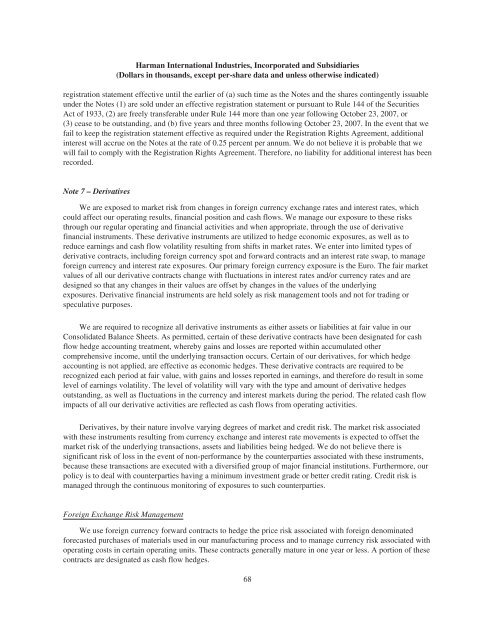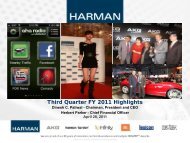You also want an ePaper? Increase the reach of your titles
YUMPU automatically turns print PDFs into web optimized ePapers that Google loves.
<strong>Harman</strong> International Industries, Incorporated and Subsidiaries<br />
(Dollars in thousands, except per-share data and unless otherwise indicated)<br />
registration statement effective until the earlier of (a) such time as the Notes and the shares contingently issuable<br />
under the Notes (1) are sold under an effective registration statement or pursuant to Rule 144 of the Securities<br />
Act of 1933, (2) are freely transferable under Rule 144 more than one year following October 23, 2007, or<br />
(3) cease to be outstanding, and (b) five years and three months following October 23, 2007. In the event that we<br />
fail to keep the registration statement effective as required under the Registration Rights Agreement, additional<br />
interest will accrue on the Notes at the rate of 0.25 percent per annum. We do not believe it is probable that we<br />
will fail to comply with the Registration Rights Agreement. Therefore, no liability for additional interest has been<br />
recorded.<br />
Note 7 – Derivatives<br />
We are exposed to market risk from changes in foreign currency exchange rates and interest rates, which<br />
could affect our operating results, financial position and cash flows. We manage our exposure to these risks<br />
through our regular operating and financial activities and when appropriate, through the use of derivative<br />
financial instruments. These derivative instruments are utilized to hedge economic exposures, as well as to<br />
reduce earnings and cash flow volatility resulting from shifts in market rates. We enter into limited types of<br />
derivative contracts, including foreign currency spot and forward contracts and an interest rate swap, to manage<br />
foreign currency and interest rate exposures. Our primary foreign currency exposure is the Euro. The fair market<br />
values of all our derivative contracts change with fluctuations in interest rates and/or currency rates and are<br />
designed so that any changes in their values are offset by changes in the values of the underlying<br />
exposures. Derivative financial instruments are held solely as risk management tools and not for trading or<br />
speculative purposes.<br />
We are required to recognize all derivative instruments as either assets or liabilities at fair value in our<br />
Consolidated Balance Sheets. As permitted, certain of these derivative contracts have been designated for cash<br />
flow hedge accounting treatment, whereby gains and losses are reported within accumulated other<br />
comprehensive income, until the underlying transaction occurs. Certain of our derivatives, for which hedge<br />
accounting is not applied, are effective as economic hedges. These derivative contracts are required to be<br />
recognized each period at fair value, with gains and losses reported in earnings, and therefore do result in some<br />
level of earnings volatility. The level of volatility will vary with the type and amount of derivative hedges<br />
outstanding, as well as fluctuations in the currency and interest markets during the period. The related cash flow<br />
impacts of all our derivative activities are reflected as cash flows from operating activities.<br />
Derivatives, by their nature involve varying degrees of market and credit risk. The market risk associated<br />
with these instruments resulting from currency exchange and interest rate movements is expected to offset the<br />
market risk of the underlying transactions, assets and liabilities being hedged. We do not believe there is<br />
significant risk of loss in the event of non-performance by the counterparties associated with these instruments,<br />
because these transactions are executed with a diversified group of major financial institutions. Furthermore, our<br />
policy is to deal with counterparties having a minimum investment grade or better credit rating. Credit risk is<br />
managed through the continuous monitoring of exposures to such counterparties.<br />
Foreign Exchange Risk Management<br />
We use foreign currency forward contracts to hedge the price risk associated with foreign denominated<br />
forecasted purchases of materials used in our manufacturing process and to manage currency risk associated with<br />
operating costs in certain operating units. These contracts generally mature in one year or less. A portion of these<br />
contracts are designated as cash flow hedges.<br />
68





